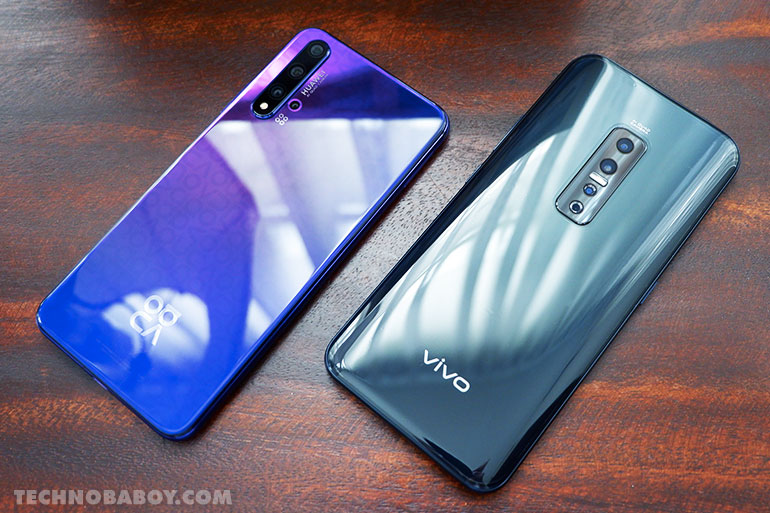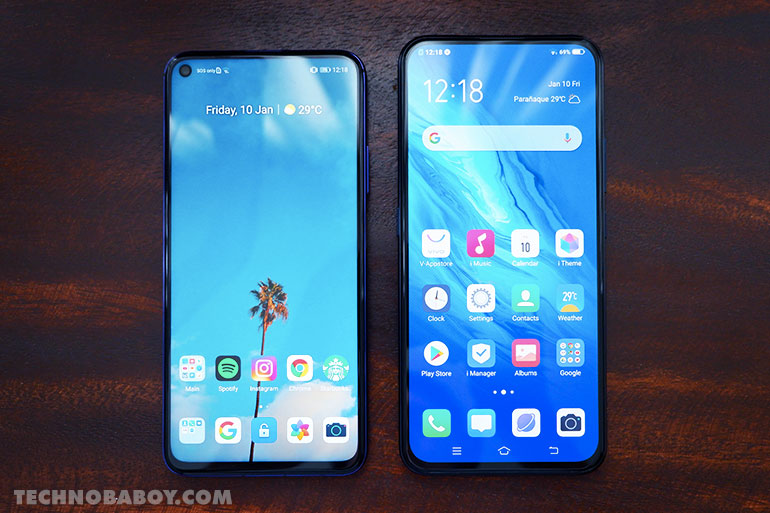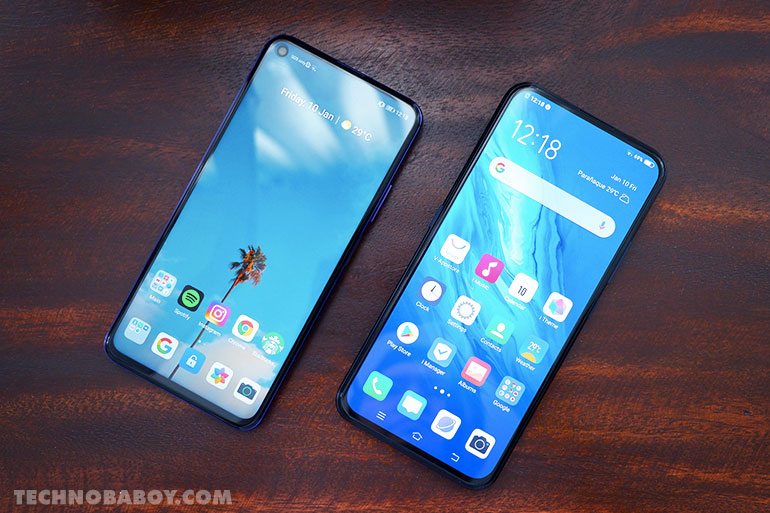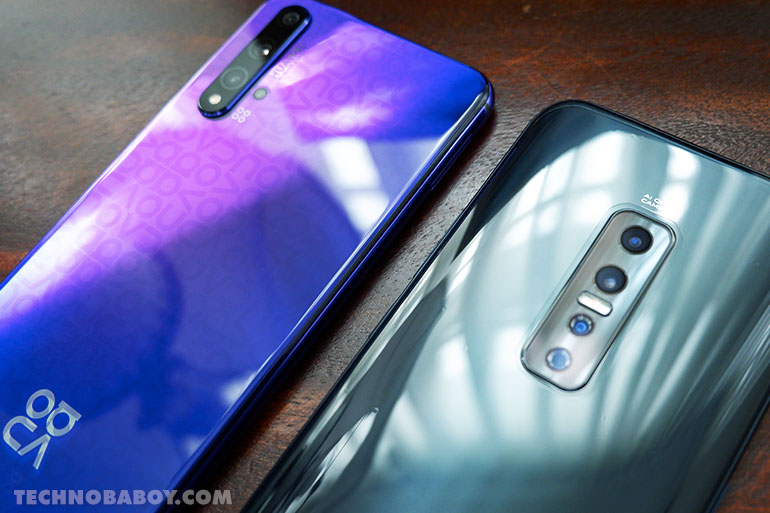We compare two popular midrange heavyweights, the Huawei Nova 5T and the Vivo V17 Pro. Both offer significant value with a lot of features in common including 48MP main cameras and 32MP selfie shooters. But the question asked, as always, is which one deserves our money and attention?
Let’s find out in this head to head specs comparison.

On one corner, we have the Huawei Nova 5T. The handset launched in the Philippines last August 2019 and features a flagship processor in the Kirin 980 along with a 6.26-inch display, 8GB RAM, 128GB storage, and a (now) modest 3750mAh battery with support for a 22.5W fast charge.
Also Read: Huawei Nova 5T Review
At the back, the Nova 5T has four cameras with a 48MP main, a 16MP ultra-wide, a 2MP macro, and another 2MP for depth. It also sports a 32MP punch hole front camera for selfies.
The Huawei Nova 5T is available in stores for PHP 17,990.
Huawei Nova 5T specs
- 6.26-inch Full HD+ IPS Display (2340 x 1080, 412ppi), 19.5:9 Aspect Ratio
- 2.6GHz Octa-Core HiSilicon Kirin 980 Processor, 7nm
- Mali-G76 720 GPU, Dual NPUs, GPU Turbo 3.0
- 8GB RAM
- 128GB Storage
- 48MP F1.8 Main + 16MP F2.2 Ultra-wide + 2MP F2.4 Macro + 2MP F2.4 Depth Quad Rear Cameras
- 32MP F2.0 Front Camera, AI Super HDR
- 4G LTE
- Wi-Fi 802.11ac, Dual Band
- Bluetooth 5
- GPS, AGPS, GLONASS, BeiDou
- Fingerprint Scanner (Side-mounted)
- Face Unlock
- USB Type-C
- EMUI 9.1, Android 9 Pie (Updated to EMU 10, Android 10)
- Midsummer Purple, Black, Crush Blue
- 3,750mAh Battery, 22.5W SuperCharge Fast Charge
Next we have the Vivo V17 Pro. Launched last October 2019, the handset fronts a 6.44-inch AMOLED display with an in-display fingerprint scanner and dual 32MP + 8MP selfie cameras in a pop-up module.
The phone is powered by a Qualcomm Snapdragon 675AIE processor with 8GB RAM and 128GB storage. It has a relatively large 4100mAh battery with an 18W Dual Engine Fast Charge support.
For photography, the phone boasts a 48MP main, an 8MP wide, a 2MP macro, and a 2MP depth cameras.
The Vivo V17 Pro is available in stores for PHP 21,999.
Vivo V17 Pro specs
- 6.44-inch Full HD+ Super AMOLED Display (2400 x 1080, 408 ppi), 2.5D Glass
- Octa-core Qualcomm Snapdragon 675AIE Processor
- Adreno 612 GPU
- 8GB RAM
- 128GB Storage, MicroSD up to 256GB
- 48MP F1.8 Main + 8MP F2.2 Wide-angle + 2MP F2.4 Super Macro + 2MP F2.4 Depth, LED Flash
- 32MP F2.0 + 8MP F2.2 Dual Front Cameras, Pop-Up Module, LED Flash
- 4G LTE, Dual SIM
- Wi-Fi 802.11ac, Dual Band
- Bluetooth 5
- GPS, GLONASS, BDS
- In-display Fingerprint Scanner
- USB Type-C Port
- Funtouch 9.1, Android 9 Pie
- 4,100 mAh Battery, 18W Dual Engine Fast Charge
Design
These two brands have design languages at the opposite ends of each other.
The Nova 5T comes in two colors, Midsummer Purple and Crush Blue. It has a simpler, more classic form factor with a modern glass front and back build sandwiching an aluminum frame. The back panel has the 3D holographic design with the new nova iconography, which gave it an edgier and youthful appeal.

The 5T is also sexier and flaunts a smaller, thinner, and narrower body. I prefer this one’s size as it fits my hands quite nicely.
The Vivo V17 Pro, on the other hand, features a curvier, more modern form factor with 2.5D front glass that flows to the side. The phone is noticeably larger too with a glass front and back but with a plastic frame.
Despite the difference in materials, both phones actually feel good in the hand. They’re both pretty solid and well-built, but the metal frame of Nova 5T gives it a more substantial build.

Display
The Nova 5T has a 6.26-inch full HD IPS display with a resolution of 2340 x 1080 and a pixel density of 412ppi. It also has a 19.5:9 aspect ratio.
The Vivo V17 Pro has a larger 6.44-inch full HD AMOLED display with a 2400 x 1080 resolution, a pixel density of 408 ppi. It has a slightly taller 20:9 aspect ratio.
Both handsets have impressive displays. The Vivo V17 Pro’s full screen OLED panel is brighter and has more color saturation. The Nova 5T’s IPS panel has decent sharpness, ample brightness and more natural colors.
Performance
The Vivo V17 Pro is powered by an octa-core Qualcomm Snapdragon 675AIE processor with an Adreno 612 graphics chip and 8GB RAM.
The Nova 5T, on the other hand, features a 7nm last-gen flagship processor in the Kirin 980 with a Mali-G76 MP10 graphics, 8GB RAM, and dual NPUs. It also has GPU Turbo 3, which now supports more games, the EROFS file system (for better responsiveness, faster read speed and load times) and EMUI 10 (Android 10) upgrade.

In everyday use, both the Nova 5T and the V17 Pro have excellent performance. They are fast and responsive with smooth animations all around.
But as you can see in the AnTuTu benchmark results, the Nova 5T is the more powerful device. It has an overall score of 384,310 points, while the Vivo V17 Pro only posted 217,700 points.
Huawei Nova 5T
AnTuTu – 385,310
CPU 126,530
GPU 127,830
MEM 66,763
UX 64,187
Vivo V17 Pro
AnTuTu – 217,700
CPU 88,732
GPU 36,552
MEM 49,879
UX 42,537
In real world usage, the difference in chipset performance are more apparent when it comes to gaming. The Nova 5T’s AnTuTu GPU score of 127,830 means it can easily handle more graphics heavy games, while with the V17 Pro’s GPU score of 36,552 means it might stutter a bit at higher graphics settings.
Using the 3DMark Benchmark – Sling Shot Extreme test, the Nova 5T got an overall score of 2,329 points. The V17 Pro got 1,092 points.
Moreover, the Nova 5T unlocks faster with a physical fingerprint scanner tucked in the power button. I find this setup more convenient as my digits naturally rests on this spot.
The V17 Pro’s in-display fingerprint scanner is also quick, but it’s nowhere near the speed and responsiveness of its physical counterpart.
Cameras
The Huawei Nova 5T comes with a total of five cameras — four at the back with a 48MP main, 16MP ultra-wide, 2MP macro, and 2MP depth sensors; and one in front with a 32MP sensor.
The Vivo V17 Pro, on the other hand, has six cameras in total. It offers a slightly similar configuration at the back with a 48MP main, 8MP ultra-wide, 2MP macro, and 2MP depth sensors. For selfies, it has a pop-up module with dual 32MP + 8MP camera setup.
Check out the sample photos below. The Nova 5T is on the left, and the V17 Pro is on the right. The images have been resized with quality set to 60.
Overall, I find the Nova 5T to deliver better, more natural looking photos most of the time. It has more detail and better dynamic range. The Vivo V17 Pro isn’t too far behind though.
When it comes to selfies, both the Nova 5T and Vivo V17 Pro do a good job at producing pleasing photos. But the latter does it a bit better with warmer, more natural skin tones and details.
Battery
The Nova 5T packs a 3,750mAh battery with support for a 22.5W fast charge. With most mid-rangers packing 4k and up batteries, this may seem a little lacking. But thanks to the smaller display and efficient AI processor, it lasts a day with moderate usage. Charging to 100% takes 1.5 hours.
The Vivo V17 Pro has a larger 4,100 mAh battery with support for an 18W Dual Engine Fast Charge. This too typically lasts a day with moderate usage. Charging to 100% takes almost 2 hours.
Despite the capacity advantage, they’re pretty much even when it comes to power management and usage. But the Nova 5T takes less time to charge to 100%.

Final Thoughts
Choosing between the two is pretty tough. On one hand, we have the Huawei Nova 5T. It is cheaper, has a more powerful processor, a good set of cameras, and EMUI 10.
On the other, we have the Vivo V17 Pro. It’s more expensive, but it does have an AMOLED display, a more modern design, a better selfie camera, and an in-display fingerprint sensor.
Personally, I prefer the Nova 5T for its size and dimensions. It just fits my hand better. Plus, it’s hard to ignore the more powerful Kirin 980 processor. It gives me security that it would age more gracefully with apps and games.
But that’s me. In the end, whatever you choose will ultimately depend on either your preference or your budget.




















1 Comment
Nova 5t wins, flagship chipset, mid range price.